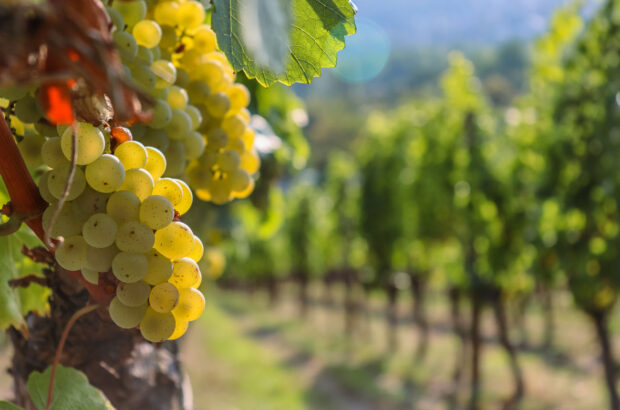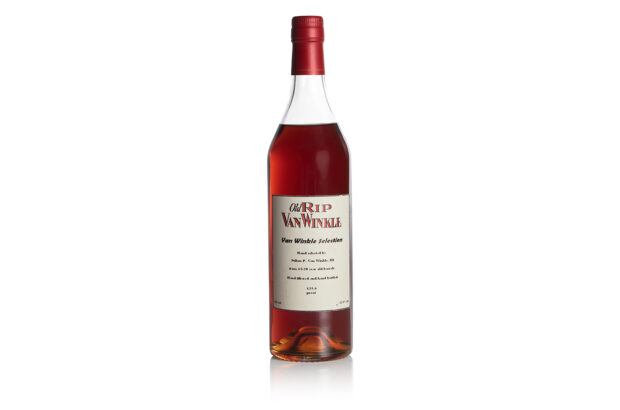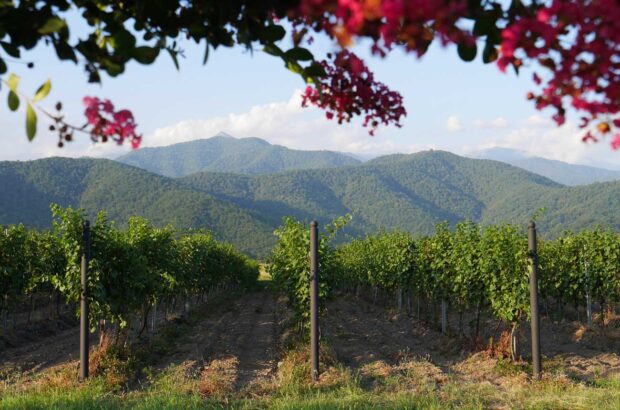In summer, Provence offers brilliant blue skies and Mediterranean beaches. The winters can be a bit wetter, but they are still relatively warm, especially by the sea, where pines and oaks give way to palm trees, vibrant purple bougainvillaea and citrus orchards.
Provence’s southernmost tip, around Bandol and La Londe, is on roughly the same latitude as Bolgheri in southern Tuscany. The region is famous for its Grenache-based rosés and beautiful beachside living, while its limestone garrigues, stunning scented lavender fields (in bloom June into August) and hilltop villages have attracted artists and tourists to the area for more than a century.
When dining in small countryside bistros, in addition to the ubiquitous rosés, expect to find a range of traditional Syrah-dominant reds and Rolle-dominant whites that aren’t typically found outside of the region. Much of Provence’s modern viticultural history can be traced back to the introduction of the railway. The Permian depression – a low-lying area whose geology dates back to the Permian Period (299-251 million years ago) – that runs from Toulon eastwards to around Fréjus, passing through Vidauban, has been a communications and transport corridor since Roman times and in the 1850s, the railway from Marseille was built through it, linking up with Nice by 1864. Many of the Côtes de Provence appellation’s vineyards lie within a few kilometres of this line, with easy access to export markets a key consideration. This historic heartland is the easiest region to visit by bicycle. The hills of Coteaux Varois and the lavender fields of the Luberon are mostly out of reach without a car.
A secondary railway line was opened by the last decade of the 19th century, linking Nice with the Durance valley via Grasse and the grape growing heartlands of northern Provence: Callas, Flayosc, Lorgues and Rians. The line was discontinued after World War II, and much of its length is now quiet, cycle-friendly roads, often running side-by-side with modern, wider ones.

The Aygalades viaduct in Marseille, part of a railway that passes through the Côtes de Provence appellation. Credit: iStock / Getty Images Plus
Day one
Arrival, Les Arcs, Draguignan & environs
The reintroduced sleeper trains from Paris to the south of France mirror the former Le Train Bleu – the iconic train that swept tourists to the riviera between 1886 and 2003. Departing from Paris Gare d’Austerlitz every evening (usually between 8.50pm and 9.30pm; check timetables), the sleeper today stops at Marseille, Toulon, Les Arcs/Draguignan and St-Raphael/Fréjus – all of which offer easy connections to vineyards. If you’re arriving from further afield, Nice airport is very well connected, and most trains to Les Arcs take a little over an hour, leaving roughly hourly from the airport station.
Les Arcs is a good first stop and base for a few days. Start the day at a café in the plane tree-shaded main square of this slightly sleepy, medieval Provençal village. The square is lined by small restaurants and cafés, mostly frequented by locals and serving local wines. Walk 15 minutes through the old town centre and you’ll find the little-known Domaine Valette (+33 [0]4 94 73 30 55), a small family-run estate; the wines are charming, authentic and inexpensive. Then, if you’re looking for some luxury, the one-star Michelin restaurant Le Relais des Moines is just down the road.
About 20 minutes’ walk from the station, on the other side of the railway, is the Maison des Vins of Côtes de Provence. Offering a free tasting of six rosés, six reds and four whites from across the appellation, this is an absolute must for an introduction to the wines of the area. You’ll be walking past Château Saint Pierre and the Cellier des Archers cooperative on the way, both of which also offer free tastings.
Les Arcs is also a good spot for bicycle lovers. The station is the junction with the former line to Draguignan, now a cycle path. Château Sainte Roseline and Château Font du Broc are both a short distance from this cycle path and worth a visit – especially if you can arrange to see the former’s private 11th-century chapel, notable for its artworks by Chagall and Giacometti (from €12 per person).
In Draguignan, stop for lunch at La Table de Martine (+33 [0]4 94 68 00 09), an exceptional family-run bistro serving local and seasonal food. There’s even a growing natural wine scene here, with new arrivals like Pulpe and Foudre offering a range of wines (not all local) and small plates.
For the more adventurous cyclists, continue on the EuroVelo 8 cycle highway. On sometimes busy roads (especially in summer) from Draguignan, the route continues up through central Provence and towards the Luberon. Beyond Flayosc, to Lorgues and Salernes, the route mostly follows the old railway line and traffic is very quiet. The pine trees give way almost entirely to oak forests, and if you’re here in the dead of winter, expect frost or even a little snow.

The cobbled streets of the medieval village of Les Arcs. Credit: Kumar Sriskandan / Alamy Stock Photo
Bike rentals in Provence: a few good options
Dragui Cycles: 245 avenue du 4 Septembre, Draguignan
A short walk from the centre of town: ‘an essential service provider in Draguignan for the rental of mountain bikes, road bikes and electric bikes’, according to the Provence-Alpes-Côte d’Azur Tourism Board. Tariffs from €18 to €45 per day and up to €100-€245 for seven days.
L’Oustaou d’Aqui: Blvd Saint Pierre, Les Arcs sur Argens
Reasonably priced holiday accommodation, bike hire and more. Conveniently positioned in the centre of town, ‘five minutes’ easy walking’ from Les Arcs-Draguignan station, with an informative website that includes plenty of things to do in the local area.
Mondovélo Pertuis: 36 rue François Gernelle, Pertuis
Mountain bike hire from €24 a day, road bikes €35, e-bikes €40, with a wide range of choice and advice from an expert and passionate team. Open Monday to Saturday.
Vignes à Vélo, Les Arcs sur Argens
From April to October, the mairie (town hall) in Les Arcs offers organised tours on electric bikes, visiting wineries in the local area. Wednesday to Saturday, booking fee €35 per person (minimum age 14) plus additional tariffs according to how many estates are visited across one, two or three days; groups up to 10 people. It’s popular, so you’ll need to book well ahead.
For more options, the Var Tourisme website has an interactive map with bike rental providers from across the region, as well as information about cycling tours and routes.
Day two
Explore Les Arcs to Lorgues
If going further, or perhaps on a second day, Château de Berne just north of Lorgues is a great place to stop for lunch – choose between the one-star Michelin (and Michelin Green Star) Le Jardin de Berne or opt for the informal Bistrot du Château (the pizzas are excellent). Afterwards, you can tour the vines, either on the estate’s 30km of signposted mountain bike paths (e-MTB rental is possible at the estate) or 100km of footpaths. The five-star hotel is excellent, but for a more affordable option (and brilliant, hearty food), continue to Lou Cigaloun in St-Antonin-du-Var, just along the EuroVelo 8. Chateau Mentone, also in St-Antonin, is a bit further, situated right on the former railway. There is a restaurant, rooms, a small spa and guided wine tastings. They also offer e-bike rental and charging.
Lorgues is full of great options, including Château La Martinette, which has a restaurant and also offers guided tours of the estate with a wine tasting and cheese pairing (€35 per person). A nearby local institution – I first went there as a toddler and cooled off running around in the garden sprinklers – is the one-star Michelin restaurant Chez Bruno. The food is simply outstanding, with truffles served at every course, and it is particularly good at catering for vegetarians and special dietary requirements.
Loop back to Les Arcs southeast via Taradeau – this isn’t a cycle path, but the road is wide and not too busy. Stop off at the cru classé Château de Saint-Martin. Try its Comtesse rosé, partially aged in mulberry-wood barrels – a nod to the region’s once-flourishing silkworm industry. Or, take a detour via nearby Vidauban to Château d’Astros, a gorgeous old château surrounded by plane tree-lined avenues, where the film adaptation of Marcel Pagnol’s Le Château de Ma Mère was filmed.
Adventurous cyclists can take a further detour, going from Lorgues towards Draguignan on the D562, which passes by Château Roubine, then taking a right onto the D57 to find the excellent Château Saint-Esprit, then the D73 south via Domaines Ott’s Château de Selle on the way to Taradeau. These roads are fairly quiet and cyclist-friendly. If you can face the steep uphill climb around Taradeau, head to the Tour du Taradel, a medieval watchtower with stunning views, even from the bottom. Taradeau and Vidauban are both also accessible by a short, if infrequent, bus service from Les Arcs.

Plage Notre-Dame on the island of Porquerolles. Credit Vincent Pommeyrol / Getty Images
Alternative routes
Hardcore riders may wish to continue west along the EuroVelo 8 and end in the town of Pertuis. From Lorgues, the EV8 continues up into Coteaux Varois en Provence, then Coteaux d’Aix-en-Provence, via Sillans, Barjols and Rians to Pertuis, about 120km from Les Arcs. But beware, this route is only for the most hardened, long-distance cyclists. The roads are quiet, but not always exclusively cycle paths. Top estates along the way include Château Vignelaure in Rians, which pioneered the Syrah-Cabernet Sauvignon red blend in Provence in the 1970s – but keep in mind that this area is relatively empty, of both vineyards and noteworthy restaurants. By Pertuis, you’ve reached the outskirts of the lavender fields of the Luberon.
You can also start or end in Pertuis. It has a railway station that is reachable in a few hours from Avignon via Marseille, and renting a bicycle is possible here. The tourist office suggests a three-day, 95km loop around the Luberon, cycling via Cadenet, Cucuron, Grambois and Mirabeau. Top estates to visit include Château la Sable in Cucuron (consider staying here – they have a cosy B&B) and Château de Clapier in Mirabeau, which hosts picnics and concerts in the gardens of the château throughout the summer.

Château Vignelaure in Rians. Credit: Herve Fabre
Day three
Island life: to Porquerolles
On a third day, or if you are looking for a bit more beach and coast, head to the island of Porquerolles, taking a train from Les Arcs via Toulon to Hyères, then the 67 bus from the station to Hyères port, followed by a ferry. The journey is a little complicated, but getting to the island really is worth it. The whole of Porquerolles is a national park in which cars are banned. Two estates have vineyards here: Domaine de l’Ile, which is owned by Chanel and notable for the high proportion of Tibouren, a variety found almost exclusively in coastal Provence, in its blends; and Domaine La Courtade. Both are excellent and serve food at small pop-up restaurants throughout the summer (note that reservations are essential).
Bicycles are widely available to rent here, but the island is small enough to stroll around on foot. While you are there, check out Villa Carmignac’s extensive modern art collection (open to the public until early November; tickets up to €16).

Credit: JP Map Graphics Ltd
Day four
Must visit: Bandol
A few stops west on the Toulon line, the Bandol region, famous for its Mourvèdre-dominant rosés and ageworthy reds, is served by several stations. Multiple estates are within easy walking distance from the station of St Cyr-Les Lecques. Château Pradeaux is the closest, but Domaine Pieracci and Domaine Maubernard are both within 15 minutes’ walk. Bicycles are permitted on local trains free of charge outside peak hours, and most of the rest of Bandol’s wine estates are easily reachable by bike along the sleepy country roads – although these can get quite steep in places!






